 |
 |
 |
| |
Pegasys/RBV Improves Fibrosis in Responders, relapsers & Nonresponders with Advanced Fibrosis
|
| |
| |
Reported by Jules Levin
"Histological benefit of peginterferon alfa-2a (40KD) (PEGASYS}) monotherapy in patients with advanced fibrosis or cirrhosis due to chronic hepatitis C"
G.T. Everson and colleagues reported results from this study at the 55th Annual Meeting of the American Association for the Study of Liver Disease: 2004 October 29--November 2: Boston, MA, USA. This research was funded by Roche, Nutley, NJ, USA.
"...Inflammatory grade and fibrosis stage improved in 23.9% and 29.3% of all patients with paired biopsies, respectively.
Fibrosis stage improved in 35.3% and 24.6% of patients in the peginterferon alfa-2a (40KD) 180 µg/week and 90 µg/week groups, respectively, vs 27.3% in the interferon alfa-2a 3 MIU tiw group (P=NS).
More patients treated with peginterferon alfa-2a (40KD) 180 µg (P=0.0201) and 90 µg/week (P=0.0084) had improvements in activity grade (27.9% and 31.1%, respectively, vs 10.9% in the interferon alfa-2a 3 MIU tiw group)..."
Patients with sustained viral response had best histological improvements, but viral relapsers & nonresponders also showed improvement although they were less likely & to lesser degree
The aim of this analysis was to evaluate the benefits of interferon-based therapy on necroinflammatory activity and fibrosis in patients with advanced fibrosis or cirrhosis.
The data for this study was obtained from a randomized controlled trial that compared 48 weeks of treatment with peginterferon alfa-2a (40KD) 90 µg/week or 180 µg/week or interferon alfa-2a (Roferon-A®) 3 MIU three times a week (tiw) in 271 patients with cirrhosis or bridging fibrosis.
Pre- and post-treatment biopsies were available from 184 patients and were graded and staged (METAVIR criteria) by one pathologist (SG) blinded to treatment and to time of biopsy. Primary end-points were improvement in fibrosis stage (defined as >=1 stage improvement) and inflammatory grade (defined as >=1 grade improvement) from baseline.
EVR was defined as >=2-log10 decrease in plasma HCV RNA by quantitative polymerase chain reaction (PCR) (COBAS AMPLICOR HCV MONITOR Test v2.0, limit of quantitation 1000 copies/mL) or undetectable HCV RNA by qualitative PCR (<100 copies/mL, COBAS AMPLICOR HCV Test v2.0) after 12 weeks of treatment.
SVR was defined as undetectable plasma HCV RNA by qualitative PCR (<100 copies/mL, COBAS AMPLICOR® HCV Test v2.0) at week 72 (24 weeks after end of treatment).
Sustained biochemical response (SBR) was defined as normalization of alanine aminotransferase (ALT) at week 72.
Early virological response (EVR), >=2-log10 decrease in hepatitis C virus (HCV) RNA or undetectable HCV RNA after 12 weeks of treatment, predicts SVR. One strategy is to discontinue treatment in patients who lack SVR. However, early discontinuation ignores potential secondary benefits of therapy, including improvements in hepatic histology. Published studies suggest that interferon-based treatment slows progression of hepatic fibrosis. Patients with advanced fibrosis and compensated liver disease have lower rates of SVR.
In the only Phase III multinational trial of patients with advanced fibrosis and compensated liver disease monotherapy with peginterferon alfa-2a (40KD) 180 µg/week produced significantly higher SVR rates than conventional interferon alfa (P=0.001). We examined data from this trial to determine the effect of interferon-based therapy on hepatic inflammation and fibrosis. Baseline characteristics of the 184 patients are summarized in Table 1. The characteristics of patients with paired biopsies were similar to the intent-to-treat (ITT) population.
SVR was 37% and 16% in the peginterferon alfa-2a (40KD) monotherapy 180 µg/week and 90 µg/week groups, respectively, and 9% in the interferon alfa-2a 3 MIU tiw group (Table 2).
RESULTS I
Early Viral Response is significantly associated with achieving improved fibrosis, but EVR could be surrogate for SVR.
Patients achieving SVR had best improvement in fibrosis stage and necroinflammatory activity index:
(1) 63% had improved activity vs 20% for virologic relapsers & 8% for viral non-responders;
(2) 50% had improved fibrosis vs 34% of viral relapsers & 16% for viral nonresponders
(3) 80% had improved activity or fibrosis vs 42% for viral relapsers & 20% for viral non-responders
--Also important is that 34% of viral relapsers had improved fibrosis and 20% had improved activity
--as well, viral non-responders showed improved fibrosis & activity: 8% showed improved activity & 16% showed improved fibrosis
RESULTS II
Mean fibrosis stage improved between baseline and end of follow-up in the overall patient population, in patients with an SVR and in patients with a virological relapse during followup (P<0.0001).
Fibrosis tended to improve in virological nonresponders (P=0.067).
Body mass index (BMI) <=30 kg/m2, EVR, SBR, and SVR predicted improvement in fibrosis and activity by univariate analysis. In addition, ALT quotient >4 and infection with HCV genotype non-1 also predicted necroinflammatory activity.
Multiple regression analyses of baseline characteristics demonstrated significant associations of BMI <=30 kg/m2 with fibrosis response (P=0.0619), and activity grade (3 vs 2) and HCV genotype (non-1 vs 1) were significant predictive factors with activity improvement (P=0.0002 and P=0.0005, respectively).
When EVR was added to the regression analysis it was the single significant predictor for improvement in fibrosis (P=0.0014).
EVR (P=0.0293), baseline grade (3 vs 2, P=0.0001) and infection with HCV genotype non-1 (P=0.0361) were significant predictors for activity improvement.
MEAN CHANGE FROM BASELINE IN FIBROSIS STAGE:
SVR: -1.0000 (p<0.0001)
Viral Relapsers: -0.4407 (p<0.0001)
Viral Nonresponder: -0.1529 (p=0.0669)
MEAN CHANGE FROM BASELINE IN ACTIVITY GRADE:
SVR: -0.6500 (p<0.0001)
Viral Relapsers: -0.1356 (p=0768)
Viral Nonresponders: +0.1176 (p=0.0383)
AUTHOR SUMMARY
Pegylated interferon plus ribavirin is the current treatment standard for patients with chronic hepatitis C (CHC), including those with advanced fibrosis and compensated cirrhosis. Patients with bridging fibrosis or cirrhosis can experience histological benefit after interferon-based treatment.
Patients treated with peginterferon alfa-2a (40KD) 180 µ}g/week (27.9% vs 10.9%; P=0.0201) and 90 µg/week (31.1% vs 10.9%; P=0.0084) had significantly greater improvement in inflammatory grade than those treated with conventional interferon alfa-2a. Peginterferon alfa-2a (40KD) 180 µg/week tended to be more effective than interferon alfa-2a in improving fibrosis stage (35.3% vs 27.3%; P=NS). Patients with virological relapse and nonresponse also obtained moderate histological benefit.
The major predictor for fibrosis improvement was EVR (Early Viral Response).EVR, baseline inflammatory grade (3 vs 2) and genotype (non-1 vs 1) were the three main predictors for the improvement of inflammatory grade.
AUTHOR CONCLUSIONS
SVR is the primary goal of therapy in patients with CHC and advanced fibrosis. However, this group of patients is more resistant to therapy.
Secondary benefits, including reduction in fibrosis and inflammation, are additional therapeutic objectives. Our findings of improvement in fibrosis and inflammation in this group of patients suggest that interferon-based therapies may delay disease progression, potentially reducing the rate of hepatic decompensation and the need for liver transplantation.
Although the greatest benefits were seen in patients with an SVR, patients with virological relapse and nonresponse also obtained moderate histologic benefit. Thus, it may be worthwhile to continue treatment in patients with bridging fibrosis or cirrhosis who do not have an EVR at week 12.
These results provide additional rationale for long-term maintenance therapy. In the Hepatitic C Antiviral Long Term Treatment Against Cirrhosis (HALT-C) trial peginterferon alfa-2a (40KD) (PEGASYS) 90 µg/week is currently being studied in patients with advanced liver fibrosis or cirrhosis.
INTRODUCTION
The primary goal of interferon-based therapy is sustained virological response (SVR); maximum reported SVR is 63% with peginterferon alfa-2a (40KD) (PEGASYS) plus ribavirin (COPEGUS).
Early virological response (EVR), >=2-log10 decrease in hepatitis C virus (HCV) RNA or undetectable HCV RNA after 12 weeks of treatment, predicts SVR. One strategy is to discontinue treatment in patients who lack SVR. However, early discontinuation ignores potential secondary benefits of therapy, including improvements in hepatic histology.
Published studies suggest that interferon-based treatment slows progression of hepatic fibrosis. Patients with advanced fibrosis and compensated liver disease have lower rates of SVR. In the only Phase III multinational trial of patients with advanced fibrosis and compensated liver disease monotherapy with peginterferon alfa-2a (40KD) 180 µg/week produced significantly higher SVR rates than conventional interferon alfa (P=0.001). We examined data from this trial to determine the effect of interferon-based therapy on hepatic inflammation and fibrosis.
|
|
| |
| |
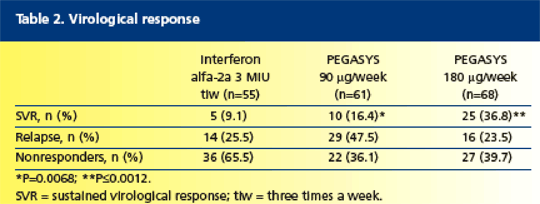 |
|
| |
| |
|
|
| |
| |
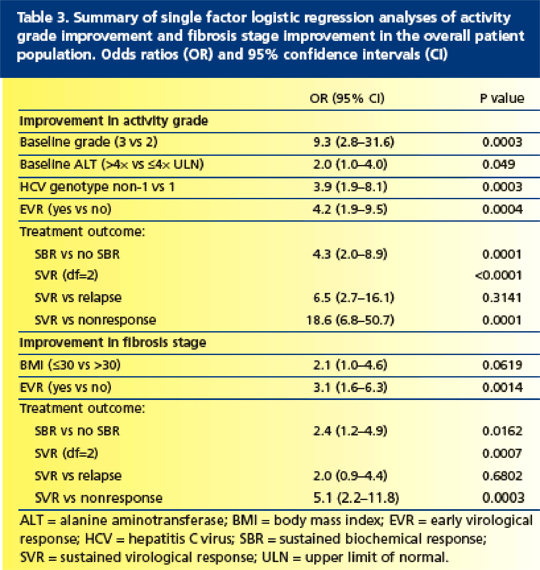 |
|
| |
| |
|
|
| |
| |
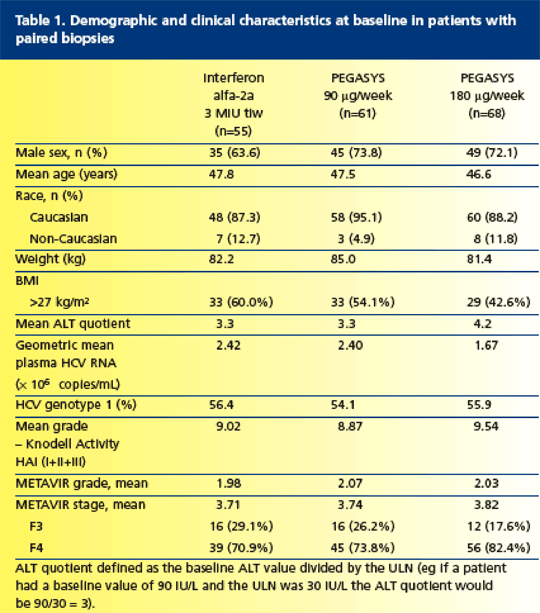 |
|
| |
| |
|
|
| |
| |
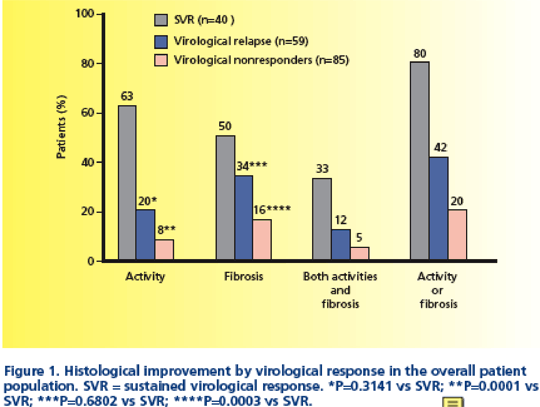 |
|
| |
| |
|
|
| |
| |
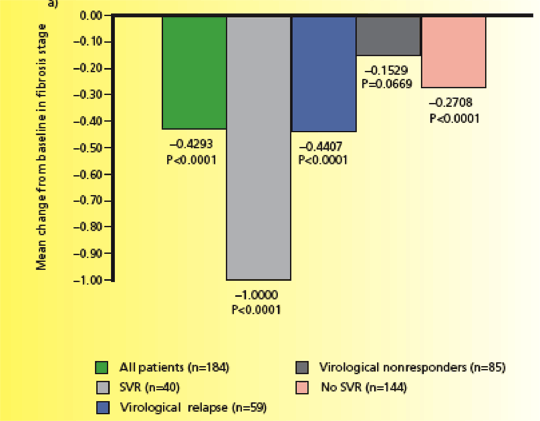 |
|
| |
| |
|
|
| |
| |
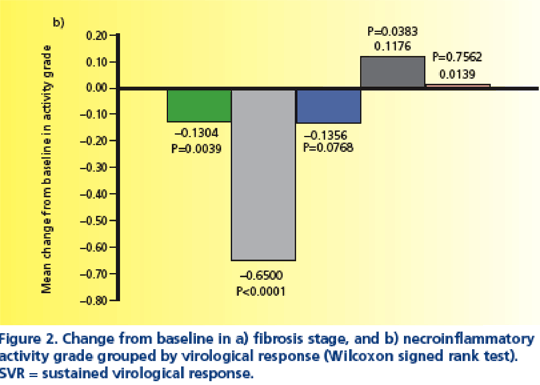 |
|
| |
| |
|
| |
|
 |
 |
|
|